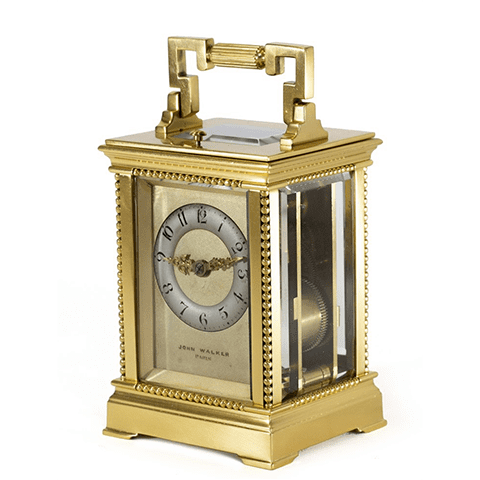From Carriage to Collector’s Shelf
Before the pocket watch and the smartphone, there was the antique carriage clock — a marvel of portable precision that once accompanied 19th-century aristocrats and explorers. It was more than a timekeeper; it was a status symbol and a technical triumph. Today, collectors and decorators alike chase the charm of the antique carriage clock, admiring not only its beauty but the remarkable engineering that kept it ticking across Europe’s dusty roads and royal parlors.
When you study an antique carriage clock, you’re looking at a piece of history designed for movement. These clocks were built with brass or gilt-bronze cases, beveled glass panels, and a practical handle — not just for show, but to carry on the road. Inside, fine escapements and jeweled movements provided accuracy that rivaled those of larger clocks of the day. Owning an antique carriage clock today is like holding a fragment of the industrial age in miniature form — compact, mechanical, and exquisitely human.
What Makes an Antique Carriage Clock So Special?
While the antique carriage clock was initially intended for travelers, its design became iconic for anyone who valued fine craftsmanship. Collectors appreciate their visible movements and balance wheels, often displayed through glass panels that invite a peek into their intricate mechanics. Unlike an antique mantel clock, which typically commands attention on a fireplace mantle, the antique carriage clock exudes refinement through itsportability and precision.
The artistry in these clocks goes beyond function. Some feature hand-painted enamel dials, engraved cases, and even repeating mechanisms that strike the hour at the press of a button. Such features make every antique carriage clock a conversation piece — not just a relic.
Why Collectors Seek Antique Carriage Clocks
The appeal of the antique carriage clock lies in its dual nature — part tool, part treasure. Each clock tells a story: perhaps of a Victorian gentleman crossing the Channel, or a French craftsman laboring over its escapement. Modern enthusiasts who search for an antique clock for sale often start with carriage clocks because they blend mechanical artistry with manageable size.
Compared to the grandeur of an antique mantel clock, a carriage clock offers a more intimate experience. You can lift it, turn it, and admire the way light dances off the beveled glass. Many who begin with one antique carriage clock soon find themselves drawn into the broader world of clock collecting, discovering the lineage between carriage, mantel, and bracket clocks.
Identifying a True Antique Carriage Clock
Not every old-looking piece is authentic. A genuine antique carriage clock typically features a solid brass case, a visible escapement, and often bears a French maker’s signature engraved on the backplate. Look for craftsmanship — beveled glass, original keys, and consistent patina. Reproductions lack the depth of tone and weight that define an accurate antique clock.
If you’re browsing an antique clock for sale, always ask for provenance or restoration details. The market has its share of repaired pieces, and while a careful restoration can enhance value, excessive replacement of parts may reduce authenticity.
Where to Find and Display Your Carriage Clock
Today’s collectors find an antique carriage clock through reputable auction houses, estate sales, or trusted dealers who specialize in horology. When you see an antique clock for sale, be mindful of condition — especially the movement’s function and the integrity of the case.
Once acquired, display your antique carriage clock in a well-lit but stable environment. Avoid direct sunlight or humidity, as both can dull brass and distort mechanics. Unlike an antique mantel clock, which may dominate a room, a carriage clock invites close inspection — best appreciated on a side table, desk, or curio shelf where its gleam and ticking can be admired up close.
The Lasting Legacy of the Carriage Clock
In an age of digital precision, the antique carriage clock reminds us that craftsmanship once defined progress. Each one was made by hand — a collaboration between engineer and artist. To hold such a piece is to feel time differently: not in seconds and minutes, but in centuries.
Collectors may chase many forms of the antique clock, from ornate mantel designs to towering regulators, but few rival the personality of a carriage clock. It’s both humble and refined, a mechanical traveler that refuses to be forgotten.
So the next time you come across an antique carriage clock, pause and listen. Beneath its polished surface lies a story of movement, invention, and elegance — one that continues to keep perfect time.


